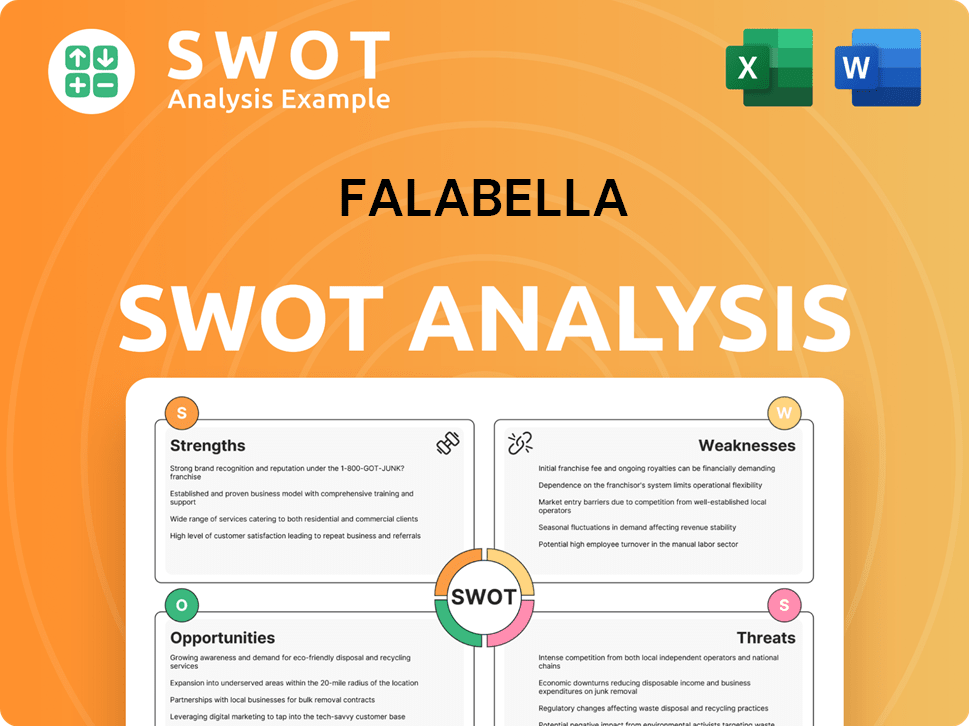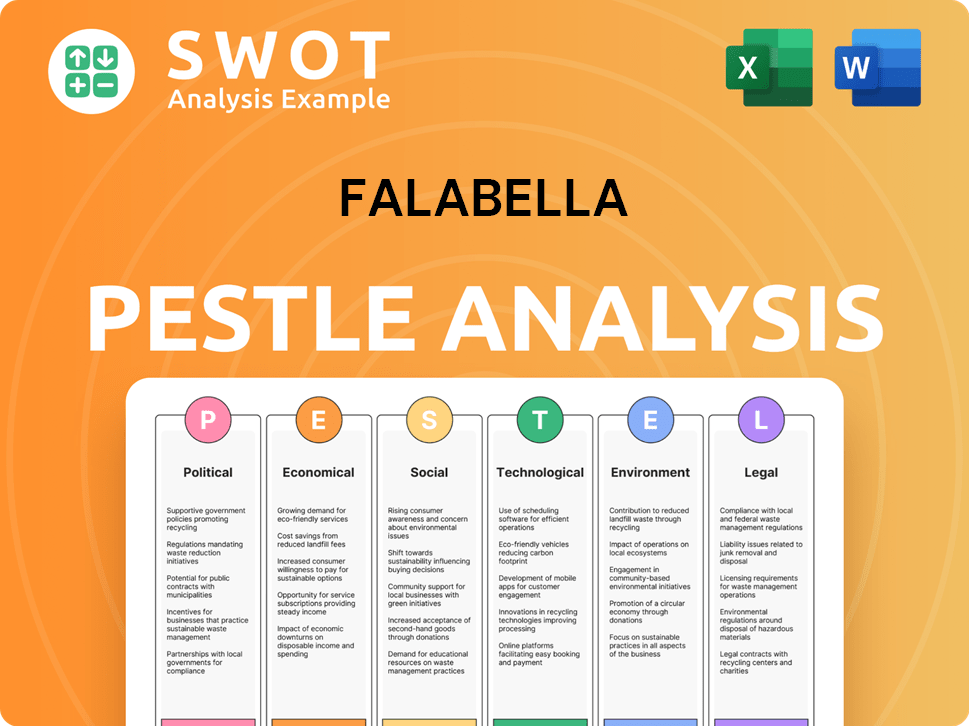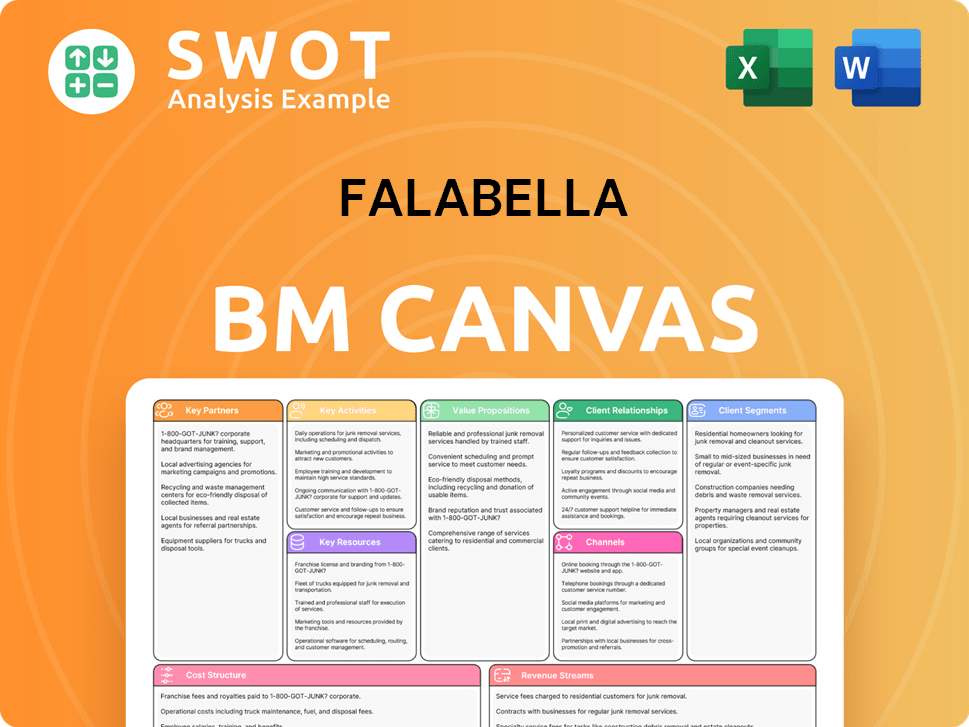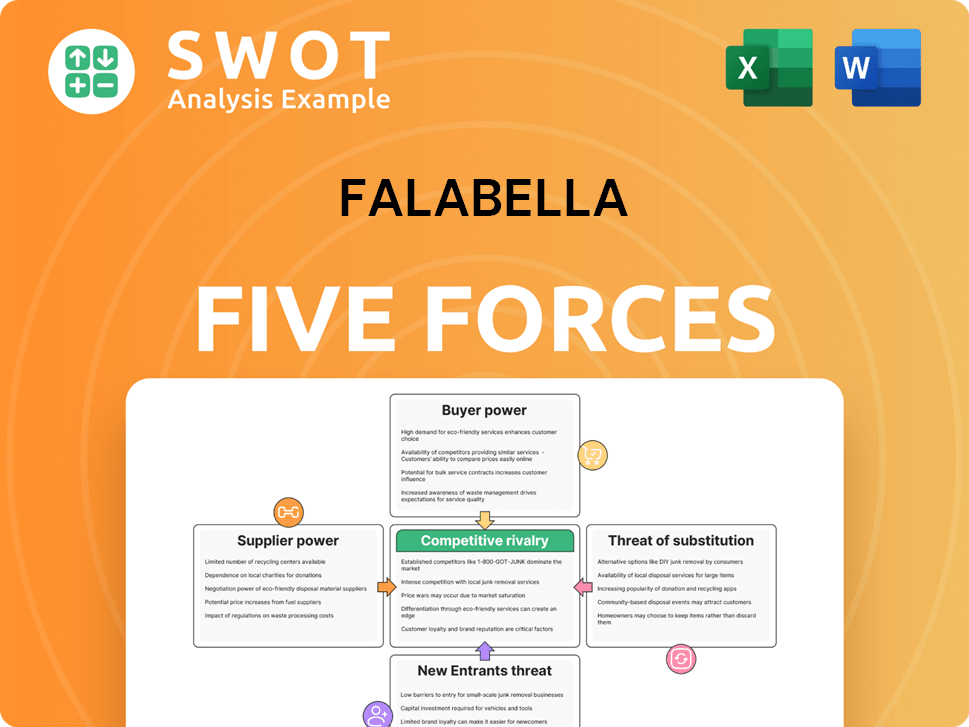Falabella Bundle
How Does Falabella Dominate the Latin American Retail Landscape?
From its humble beginnings as a tailor shop in 1889, Falabella has transformed into a retail powerhouse. This evolution showcases a dynamic Falabella SWOT Analysis that has fueled its growth across diverse sectors. Discover how this multinational giant leverages its

Falabella's success story is a masterclass in adapting to the ever-changing retail environment. Its robust
How Does Falabella Reach Its Customers?
The company, a major player in Latin American retail, employs a multifaceted sales strategy to engage its extensive customer base. This strategy incorporates a blend of physical stores, e-commerce platforms, and specialized websites. This approach allows the company to cater to diverse consumer preferences, ensuring accessibility and convenience across various channels. The company's success is significantly influenced by its ability to integrate these channels seamlessly, offering a unified shopping experience.
The company's sales channels are a critical component of its business model, enabling it to reach a wide audience across Latin America. The company's strategy focuses on omnichannel integration, which is crucial for adapting to evolving consumer behaviors. This integration is supported by substantial investments in technology and infrastructure, ensuring a cohesive and efficient customer experience. The company's commitment to both physical and digital channels demonstrates its adaptability and forward-thinking approach in the dynamic retail environment.
The company's sales strategy is designed to maximize customer reach and enhance the shopping experience. This approach includes a combination of physical stores, e-commerce platforms, and specialized websites. The company's strategy is supported by significant investments in technology and infrastructure. The company's strategy is focused on omnichannel integration, which is crucial for adapting to evolving consumer behaviors.
The company operates a vast network of physical stores, including department stores, home improvement stores, and supermarkets. In 2024, the company allocated US$270 million, or 53% of its investment plan, to expand and modernize its store network. This included US$113 million for new store openings and US$157 million for upgrading existing stores. The company plans to open 15 new stores in 2025, prioritizing Chile, Peru, and Mexico.
The company's e-commerce platform, Falabella.com, is evolving to offer a wide range of products. Digital adoption is critical, with over 45% of deliveries in Q1 2024 made through Click & Collect. In 2024, the sale of sellers on the e-commerce platform grew 9% year-over-year, reaching 25% of the online GMV. The company invested US$200 million in technology in 2024 to advance e-commerce and digital banking services.
The company emphasizes omnichannel integration to provide a seamless shopping experience. Close to 70% of deliveries from retailers are completed in less than 48 hours. The company's loyalty program, with 20.3 million participants in the Andean region as of Q3 2024, integrates customers across its channels. The company's focus on both online and offline channels supports its Growth Strategy of Falabella.
The company leverages strategic partnerships to expand its reach. The partnership with IKEA has led to the opening of IKEA stores in Latin America. Falabella Card has partnered with Palenca in Mexico to enhance financial inclusion. The company's loyalty program, with 3.3 million redeeming customers in Q3 2024, further integrates customers across its diverse channels.
The company's sales strategy focuses on a combination of physical retail, e-commerce, and strategic partnerships. This approach enables the company to reach a broad customer base and adapt to changing consumer preferences. The company's investments in technology and infrastructure support its omnichannel strategy, ensuring a seamless shopping experience.
- Physical Retail: Department stores, home improvement stores, and supermarkets.
- E-commerce: Falabella.com and specialized digital platforms.
- Omnichannel Integration: Click & Collect, fast delivery, and loyalty programs.
- Strategic Partnerships: IKEA and Palenca.
Falabella SWOT Analysis
- Complete SWOT Breakdown
- Fully Customizable
- Editable in Excel & Word
- Professional Formatting
- Investor-Ready Format

What Marketing Tactics Does Falabella Use?
The Revenue Streams & Business Model of Falabella utilizes a comprehensive marketing strategy, blending digital and traditional tactics to boost brand awareness, generate leads, and drive sales. This approach is heavily data-driven, allowing for precise targeting and personalized customer experiences. The company's focus on omnichannel retail is central to its marketing efforts, ensuring a seamless experience across all touchpoints.
Digital marketing plays a crucial role in the Falabella sales strategy, with content marketing, SEO, paid advertising, email marketing, and social media forming the core. The company’s Fmedia retail media platform has proven particularly effective, achieving significant sales growth for participating brands. Furthermore, Falabella actively engages in innovative physical activations to enhance customer engagement.
Customer data and personalization are at the heart of Falabella's marketing efforts. By understanding customer behavior, the company delivers tailored experiences. This customer-centric approach drives decision-making and innovation, ensuring marketing efforts are targeted and effective. The company's investment plan for 2025 includes US$166 million dedicated to strengthening its technological capabilities, which directly supports its data-driven marketing efforts.
Falabella's digital marketing strategy encompasses content marketing, SEO, paid advertising, email marketing, and social media. These channels are managed with a data-driven approach to maximize effectiveness. The company leverages its website and social media platforms to reach a broad audience.
The Fmedia platform is a key component of Falabella's marketing campaigns, achieving impressive results. Participating brands saw a 30% sales growth, with ROIs reaching up to 9x during key events in 2024. Over 3,000 brands invested in sponsored products through Fmedia in 2024, highlighting its success.
Falabella's omnichannel retail approach is evident in its integrated marketing efforts. The company changed its Falabella.com logo to green in March 2024 to reinforce its omnichannel identity. The 'Puntos + Pesos' initiative in Chile allows customers to combine loyalty points with money, further integrating its financial and retail offerings.
Data-driven marketing, customer segmentation, and personalization are central to Falabella's strategy. The company uses extensive data to understand customer behavior, delivering seamless experiences across various touchpoints. This approach informs decision-making and innovation.
Falabella engages in innovative physical activations, including AI-powered experiences and interactive contests. These initiatives enhance customer engagement and brand awareness. Over 100,000 participants were engaged in these activations in 2024.
Falabella engages in strategic partnerships to enhance its customer offerings. The company was a pioneer in Latin America with Google Pay, facilitating digital payment interactions. These partnerships support its e-commerce strategy and overall customer experience.
Falabella's marketing strategy is built on a foundation of digital innovation, customer-centricity, and strategic partnerships. The company focuses on delivering seamless experiences across all touchpoints, leveraging data to personalize interactions and drive sales. This approach is supported by significant investments in technology and a commitment to omnichannel retail.
- Digital Marketing: Content marketing, SEO, paid advertising, email marketing, and social media are key components.
- Fmedia Platform: A successful retail media platform driving sales growth and high ROIs for participating brands.
- Omnichannel Integration: Efforts to unify physical and digital experiences, such as the green logo for Falabella.com.
- Data-Driven Decisions: Utilizing customer data for segmentation, personalization, and targeted marketing campaigns.
- Physical Activations: Engaging customers through AI-powered experiences and interactive contests.
- Strategic Partnerships: Collaborations like Google Pay to enhance customer convenience and payment options.
Falabella PESTLE Analysis
- Covers All 6 PESTLE Categories
- No Research Needed – Save Hours of Work
- Built by Experts, Trusted by Consultants
- Instant Download, Ready to Use
- 100% Editable, Fully Customizable

How Is Falabella Positioned in the Market?
The brand positioning of Falabella is centered around the purpose of 'Making life simpler and more enjoyable.' This message is consistently communicated across its diverse business units, including retail, financial services, and shopping centers. The company strategically positions itself as a leading physical-digital ecosystem in Latin America, focusing on a comprehensive offering to differentiate itself in the market. This approach is a key element of the Falabella sales strategy.
Falabella's approach to brand positioning emphasizes value, convenience, and sustainability to resonate with its target audience. It aims to provide 'the best products, services, and advice at the best market price.' Its commitment to sustainability is a critical aspect of its brand identity. This focus is integral to the Falabella marketing strategy.
The company's omnichannel approach is a core differentiator, providing a seamless customer experience across all touchpoints. This integration is evident in its e-commerce strategy, where Falabella Retail and Falabella.com collaborate to offer a wide range of categories. This approach is a key component of the Falabella business model.
Falabella focuses on delivering a seamless customer experience across all touchpoints, integrating physical and digital channels. This is achieved through an omnichannel approach that enhances customer convenience and satisfaction. The company continuously refines its online platforms and integrates digital services to meet evolving consumer expectations.
Falabella is committed to sustainability, reflected in its inclusion in the Sustainability Yearbook for the seventh consecutive year. In 2023, the company achieved a 20% reduction in controlled emissions compared to 2021 and sourced 73% of its energy from renewable sources. The LEED Gold certified flagship store in Santiago exemplifies its commitment to environmental management.
Falabella responds to shifts in consumer behavior, such as increased digital adoption, by continuously refining its online platforms and integrating digital services. The company's e-commerce strategy, with joint offerings from Falabella Retail and Falabella.com, showcases its digital integration efforts. This is a key part of its Falabella's e-commerce strategy.
Falabella positions itself as a leading physical-digital ecosystem in Latin America. Its comprehensive offering of retail, financial, and logistical services, supported by an extensive network of stores and shopping centers, sets it apart. This positioning is crucial for maintaining its competitive advantage.
Falabella's brand positioning is strengthened by its focus on key differentiators that resonate with its target audience. These differentiators include:
- Omnichannel Approach: Seamless integration of physical and digital channels.
- Sustainability: Commitment to environmental responsibility and sustainable practices.
- Value Proposition: Offering the best products, services, and advice at competitive prices.
- Digital Innovation: Continuous improvement of online platforms and digital services.
Falabella Business Model Canvas
- Complete 9-Block Business Model Canvas
- Effortlessly Communicate Your Business Strategy
- Investor-Ready BMC Format
- 100% Editable and Customizable
- Clear and Structured Layout

What Are Falabella’s Most Notable Campaigns?
The company's sales and marketing strategy for 2024-2025 is characterized by several key campaigns focused on enhancing customer experience, expanding digital presence, and promoting sustainability. These initiatives are supported by significant investments aimed at driving growth and reinforcing the brand's position in the competitive retail market. The emphasis is on integrating physical and digital channels to meet evolving consumer expectations.
A central aspect of the company's strategy involves continuous improvement of its omnichannel capabilities. This includes substantial investments in technology, logistics, and the transformation of physical stores and shopping centers. The aim is to seamlessly blend online and offline shopping experiences, offering customers greater convenience and choice. Furthermore, the company is actively leveraging its financial services and sustainability efforts as integral components of its overall marketing approach.
These strategic campaigns are designed to drive sales performance and strengthen the brand's image. The company's approach reflects a commitment to adapting to market changes, using data to inform decisions, and building a loyal customer base. This is a crucial element of the overall Falabella sales strategy.
The ongoing evolution of the omnichannel strategy is a major campaign, with investments of US$508 million in 2024 and US$650 million planned for 2025. This includes technological enhancements, logistics improvements, and the transformation of stores and shopping centers. The goal is to deepen the integration of physical and digital channels to improve customer experience.
Falabella.com aims to offer the largest number of categories, while Sodimac and Tottus expand their specialized online offerings. The Fmedia retail media platform, with over 3,000 brands investing in sponsored products in 2024, is another key campaign, achieving sales increases exceeding 30%. This is key to Falabella's digital marketing strategy.
Banco Falabella and its credit card offerings are subject to strategic campaigns to increase loan placements and diversify product portfolios. The partnership with Palenca in Mexico, initiated in December 2023, is an example of a targeted initiative. This is part of the Falabella business model.
The company's commitment to sustainability, as recognized by its inclusion in the Sustainability Yearbook 2024 and its Net Zero 2035 commitment, serves as a continuous branding and marketing effort. This appeals to environmentally conscious consumers. This is part of Falabella's marketing campaigns.
These campaigns are supported by data-driven strategies. The company's approach to Falabella retail involves a focus on key performance indicators (KPIs) to measure success. This includes metrics related to e-commerce growth, customer engagement, and financial performance.
- Over 45% of deliveries in Q1 2024 were made through Click & Collect.
- Fmedia's physical activations, including AI-powered experiences, engaged over 100,000 participants in 2024.
- The Fmedia platform saw sales increases exceeding 30%.
- The company is focused on Falabella's customer relationship management (CRM) to enhance customer experience.
Falabella Porter's Five Forces Analysis
- Covers All 5 Competitive Forces in Detail
- Structured for Consultants, Students, and Founders
- 100% Editable in Microsoft Word & Excel
- Instant Digital Download – Use Immediately
- Compatible with Mac & PC – Fully Unlocked

Related Blogs
- What are Mission Vision & Core Values of Falabella Company?
- What is Competitive Landscape of Falabella Company?
- What is Growth Strategy and Future Prospects of Falabella Company?
- How Does Falabella Company Work?
- What is Brief History of Falabella Company?
- Who Owns Falabella Company?
- What is Customer Demographics and Target Market of Falabella Company?
Disclaimer
All information, articles, and product details provided on this website are for general informational and educational purposes only. We do not claim any ownership over, nor do we intend to infringe upon, any trademarks, copyrights, logos, brand names, or other intellectual property mentioned or depicted on this site. Such intellectual property remains the property of its respective owners, and any references here are made solely for identification or informational purposes, without implying any affiliation, endorsement, or partnership.
We make no representations or warranties, express or implied, regarding the accuracy, completeness, or suitability of any content or products presented. Nothing on this website should be construed as legal, tax, investment, financial, medical, or other professional advice. In addition, no part of this site—including articles or product references—constitutes a solicitation, recommendation, endorsement, advertisement, or offer to buy or sell any securities, franchises, or other financial instruments, particularly in jurisdictions where such activity would be unlawful.
All content is of a general nature and may not address the specific circumstances of any individual or entity. It is not a substitute for professional advice or services. Any actions you take based on the information provided here are strictly at your own risk. You accept full responsibility for any decisions or outcomes arising from your use of this website and agree to release us from any liability in connection with your use of, or reliance upon, the content or products found herein.